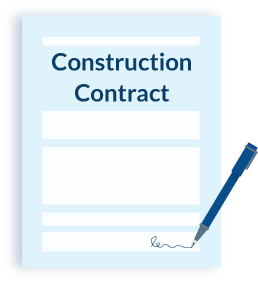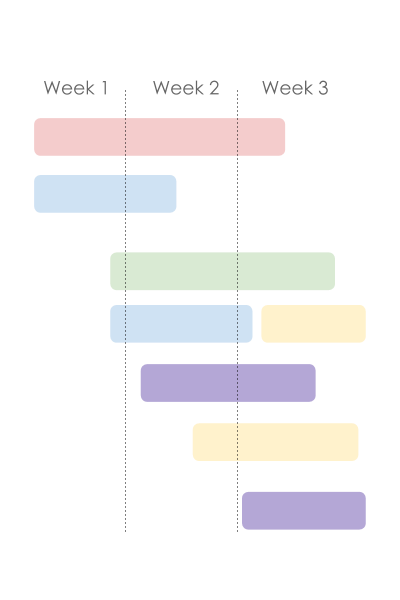
By using strong construction agreements throughout the entirety of a project, contractors are not only showing clients that they are professional and know what you are doing, but are also protecting themselves from fraud and disputes. Contractors will use many construction documents during the life of a project. Here are some of the essential documents, and how they’re used.
12 essential construction documents
While different construction projects may require specialized documents, there are 12 key documents every contractor needs to be familiar with.
1. Drawings
Drawings are among the most common type of construction documents, because they represent the final design of the project. While architectural drawings (commonly called “blueprints”) are the most well-known type of drawing, there may be several hundred pages of drawings on a project, with each showing plans for different disciplines or types of construction work.
For example, an electrical contractor uses electrical drawings to identify the location of outlets and appliances so they know what gauge wire to use and where to route it.
Drawing identification
Every drawing will identify both the discipline (the type of construction work it applies to) and the type of sheet (e.g. whether it shows a horizontal view or a vertical view). The standard document naming convention starts with a letter and ends with a number; the letter identifies which discipline the drawings apply to.
The US National CAD Standard uses 21 letter designations that correspond with a particular discipline. This naming convention makes it easy to identify which type of contractor the drawings were created for.
| Designation | Discipline |
| A | Architectural |
| B | Geotechnical |
| C | Civil |
| D | Process |
| E | Electrical |
| F | Fire Protection |
| G | General |
| H | Hazardous Materials |
| I | Interiors |
| L | Landscape |
| M | Mechanical |
| O | Operations |
| P | Plumbing |
| Q | Equipment |
| R | Resource |
| S | Structural |
| T | Telecommunications |
| V | Survey/Mapping |
| W | Distributed Energy |
| X | Other Disciplines |
| Z | Contractor/Shop Drawings |
The national standards also use number designations to denote the type of sheet.
| Designation | Sheet Type |
| 0 | General (symbols legend, notes, etc.) |
| 1 | Plans |
| 2 | Elevations |
| 3 | Sections |
| 4 | Large-Scale Views |
| 5 | Details |
| 6 | Schedules and Diagrams |
| 7 | User-Defined |
| 8 | User-Defined |
| 9 | 3D Representations |
These designators are used together in a sequence of letters and numbers.
For example:
- A-0 sheets are “general architectural drawings,” often used as a cover sheet for the document set. This often includes an index of all of the sheet types included in the set.
- AD107 is an architectural demolition floor plan
- M401 would indicate large-scale HVAC drawings
2. Bidding documents
Bidding documents are not legally binding. However, these documents do give contractors the ability to state their intentions, expectations, conditions, while also working through some very important questions early in the bidding process.
By establishing these important terms early in the process, you can easily influence how the actual construction contract is written. Further, you can avoid some of the most contentious issues in construction projects such as what to do if there is a weather delay.
3. Contract documents
The construction contract agreement is the principal agreement between the parties involved in a project. This is an essential document and should include a detailed description of the project, the contract price, and how payments will be made. It also covers the scope of the project and scheduling.
Additionally, the initial contract agreement should include state-specific information such as contract laws, liens, and insurance requirements, and a list of responsibilities and conditions both parties must follow when processing claims and resolving disputes.

Free contract template download
Download a free construction contract template that works on almost any project.
Scope of work
Clearly defining the scope of work for a project is crucial during the bidding process and throughout the construction project. Not only will the scope of work state what is to be done during a project, but it will also include different techniques you can use to complete the job, material information, and other details regarding who is responsible for different portions of work.
4. Construction schedule
A construction schedule is mainly utilized to keep a project on track and manage timeline expectations. This document may also include reasons why the schedule can be modified or what happens if there is an unavoidable delay.
A construction schedule could address what happens if the required materials cannot be obtained on time or if another contractor cannot complete their work.
Finally, a construction schedule should include necessary components for completing the project, their relative start times, their relationship to other projects, when each project should be completed by, and dates where licensing and building permit certifications are scheduled.

Use a free construction schedule template
Download free construction schedule templates for everything from managing projects to tracking payments and submittals.
5. General conditions
The general conditions document states the obligations each contractor will have throughout the construction project. These conditions most commonly include the paying party, determining when payments will be made, sourcing policies, where work will be performed, and deadlines. While not required, this document should also include details regarding how potential disputes should be resolved.
6. Special conditions
Special conditions are one of the few documents included in this list that may not be necessary. However, if you do choose to utilize special conditions, they would be included as an extension in the general conditions section.
7. Specifications
The construction specifications detail the technical requirements of a project. The specifications document will list the initial requirements and then any changes to the technical requirements will be stated under the scope of work section. The specifications document most commonly includes.
- Common standards and best practice
- Material requirements and acceptable material deviations
- Testing and certifications required for project completion
- Techniques and equipment expected to be used
8. Bill of Quantities
A bill of quantities includes all the materials and tools a contractor would need to complete a project. Further, you would have an itemized list of tools, labor, material, and miscellaneous parts, as well as pricing for every item.
9. Cost estimate
A cost estimate provides a statement of all tools, materials, and labor that a general contractor will need to complete a job and their corresponding prices.
There are two main ways general contractors create this document. The first way is to itemize and then list each cost separately with the total cost included.
Learn more: The Contractor’s Guide to Construction Estimating
The other option available to contractors is a simple lump-sum form that states the cost of the project without any breakdown of cost. In some cases, a cost estimate is combined with the specifications document.
11. Work orders
When submitting or receiving a work order, you should save this document as you may need to reference it later in the project. The maintenance of these projects ensures that a project stays on task and work is completed properly and on time. Work orders most commonly include client and contractor information, order numbers, expected completion date, and authorizing signatures.
12. List of construction insurance coverage
Insurance—specifically liability insurance—is something every contractor should submit before beginning a construction project. By keeping documentation of your insurance, you will avoid legal issues, protect your employees, and avoid being charged for accidental worksite damage.
You should not only submit insurance documents before you start working, but also keep them on hand throughout your projects.
Construction documents help prevent disputes
These documents cover issues from the scope of work to the cost of the project to your company’s insurance coverage — and help you avoid the most common issues with construction contracts. No matter what state or type of work your company specializes in, successful and reputable contractors learn how to use each of the documents in this list.
Keeping these documents organized is also key to keeping payments and other business operations smooth throughout a project, especially during the closeout process. Using software to keep track of construction documents for closeout can both save time and decrease the likelihood of missing one that delays or withholds final retainage payment.
The complexity of construction documents can vary depending on the type of contract being used, the number of parties involved in the project, and the type project being completed. Construction attorneys can help construction company owners, contractors, subcontractors, material suppliers, architects, designers, and property owners with a wide range of services before, during, and after a construction project.Further, if you are confused at all about the type of contracts you should use or what to include in these contracts, it is vital to contact a construction attorney immediately.